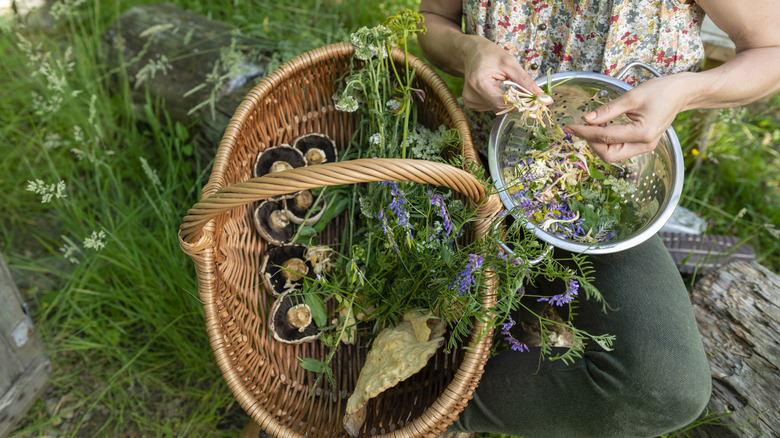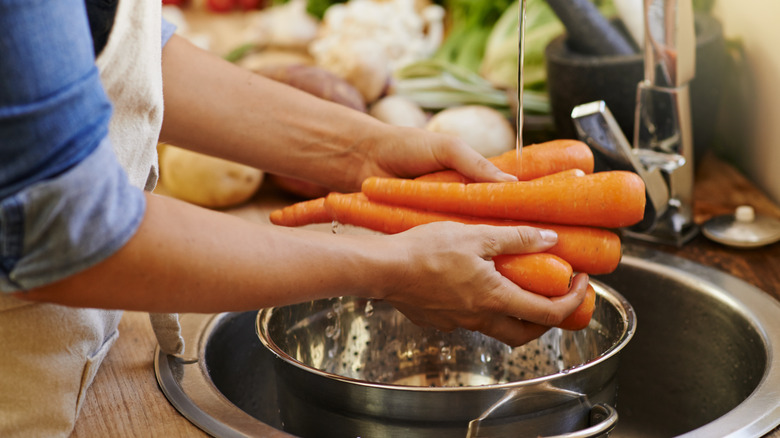What To Know About Cleaning Foraged Produce Vs. Store-Bought
Foraging has been enjoying a moment — it's the natural result of a shift toward health and nutrition coupled with the back-to-the-land shift that pushed foodies toward gardening, the cottage-core aesthetic, and "touching grass" during the pandemic. It may be the hunting-and-gathering practice that sustained our ancestors, but now, it can feel like a live-action "Animal Crossing" to collect your own wild garlic, ramps, strawberries, acorns, and wild onions. But, according to the FDA, an estimated 48 million people become ill after eating food with hidden bacteria every single year.
As viral foraging guide Alexis Nikole Nelson tells The Washington Post, "What I remind new foragers is that the veggies from the grocery store have been grown in fertilizer that often has excrement or urea in it, so just like you clean those veggies before eating, you do the same with your foraged finds." As cheerful and fun as foraging can be, it's important that foraging beginners keep safety at the front of their minds — and foraged produce plays by different rules from the stuff you'll find at the supermarket.
Different produce requires different cleaning methods
Nelson's advice is an important reminder that washing your groceries during the pandemic should have been the start of a lasting habit rather than a passing trend. Even in the grocery realm, that produce goes on a long journey from farm to store to table. Along its trek, it can encounter contaminants from nearby livestock, wild animals, soil, or water, just like foraged produce. Not to mention, grocery store produce gets touched by a lot of hands, not all of which are illness-free or hygienic.
For cleaning foraged produce, whip up a quick solution of one part white vinegar to three parts water. Soaking your produce in this solution for five to 10 minutes before rinsing knocks off substantially more bacteria than just rinsing without a presoak. Plus, thanks to the dilution, it won't leave any substantial effect on taste. Still, properly cleaning produce (store-bought or foraged) isn't a one size fits all practice.
Take extra care to avoid bacteria with foraged produce
When you think of foraging, one of the first things that comes to mind is likely mushrooms. But the vinegar bath method won't work for your tender mushies. Once fully submerged, mushrooms tend to hold on to water, which can quickly breed mold. Instead, place your foraged mushrooms in a colander to optimize drainage, then rinse with a spray-nozzle faucet attachment in the sink basin. (Be extra thorough with gilled varieties like Chicken of the Woods and chanterelles, which can conceal bugs and dirt.) You might even use a toothbrush to gently scrub away dirt from the mushroom's surface.
A simple cold water wash works well for more delicate plants like chicory or dandelions, in which case vinegar could mess with the flavor. Also, it helps to familiarize yourself with certain veggies. For instance, leeks tend to hold onto a lot of dirt, so you might give them a second or third soak to make sure the water runs clean.
Whatever you do, don't wash your produce (foraged or store-bought) with soap. We're talking cleaning products, a "gentle" dish soap, detergent, or even any commercially-manufactured products advertised as a "produce wash" of any kind. Not only are these unnecessary, but they're not certified food-safe and can leave a soapy residue, which is indigestible, per the FDA. After a good produce-washing session, the USDA recommends sanitizing your kitchen and utensils as well as disinfecting the countertops, the sink, and especially your cutting boards and knives.


